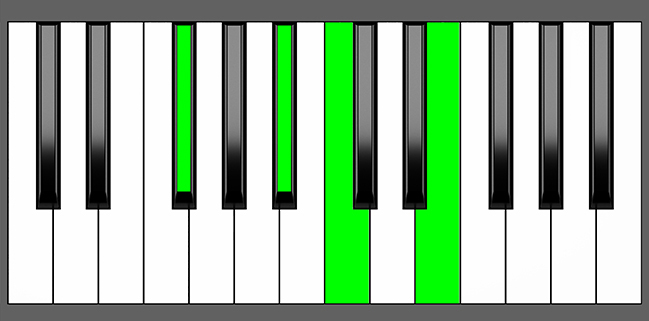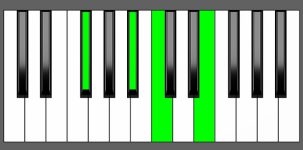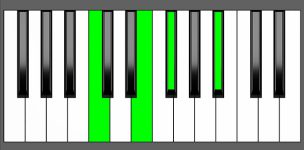Piano Diagram of Gb7b5 in Root Position

Gb7b5 is a dominant seventh chord with a flat 5th built on the Gb major scale. This chord consists of the root note Gb, the major third Bb, the diminished fifth Dbb, and the minor seventh Fb. The flat fifth creates a distinct dissonance so it can be used as a substitute for dominant chords only in specific musical contexts. If you keep reading, you will learn more about the music theory that underpins this chord.
Structure of Gb7b5
Notes |
|---|
| Gb, Bb, Dbb, Fb |
Intervals |
|---|
| R, 3, d5, m7 |
Fingers Position
Left Hand |
|---|
| 5, 3, 2, 1 |
Right Hand |
|---|
| 1, 2, 3, 5 |
How to play a Gb7b5
Play the root note Gb with your left hand. Then, with your right hand, play the notes E (Fb in this case, the minor 7th), Bb (major 3rd), and C (actually Dbb, the diminished 5th).
Gb + Fb, Bb, Dbb
Omitting the root on your right hand, you can play also one of the three inversions of the chord.
Gb7b5 Chord Inversions
The Gb7b5 chord has a total of 3 inversions:
| Root Position: | Gb | Bb | Dbb | Fb |
| 1st Inversion: | Bb | Dbb | Fb | Gb |
| 2nd Inversion: | Dbb | Fb | Gb | Bb |
| 3rd Inversion: | Fb | Gb | Bb | Dbb |
Piano Keyboard Diagrams
Gb7b5 Chord Equivalencies
If you take a 7b5 chord, you can find another 7b5 chord that has the same notes in it by either going up three steps from the root note or going down three steps from the root note.
For example, Gb is the root note of Gb7b5 (Gb, Bb, Dbb, Fb), so if you go up three steps from Gb, you get to Dbb. Therefore, Dbb7b5 has the same notes as Gb7b5. The same thing happens going down three steps: you get to a C.
Gb7b5 = Dbb7b5 = C7b5
The reason why going up three steps or going down three steps leads you to a chord with the same notes is because the interval between the root note and the diminished fifth is called a tritone. This interval is halfway between the octave and divides it into two equal parts. Therefore, going up three steps or going down three steps takes you to the same note that is a tritone away from the starting note.
So, the Gb7b5 chord is equivalent to both Dbb7b5 and C7b5 because they all have the same notes in them, even though they have different names.
Music Theory and Harmony of Gb7b5
Dominant 7b5 chords are often used as transitional chords to add an extra layer of tension to a dominant 7th chord and prepare for the resolution to the tonic. The Gb7b5 chord can substitute or enhance the Gb7 chord, commonly on the V degree in a minor key, but also on the III degree, and occasionally on other degrees as a secondary dominant chord.
Before examining the most common use of this chord, let’s learn how to build it.
Building the Gb7b5 Chord: Different Approaches
Starting from the Gb Major Scale:
To form a 7b5 chord, you combine the root, the major 3rd, the diminished 5th, and the minor 7th from a major scale.


To create a Gb7b5 chord, apply the formula R, 3, d5, m7 in the following manner:
- Begin with the Root note, Gb.
- Select the major 3rd interval, which is Bb.
- Add the 5th interval, which is Db then lower it by half step to get the diminished 5th, Dbb (C).
- Add the minor 7th interval, Fb (E).
By following this simple formula, you can create a 7b5 chord from any major scale.
by Combining Intervals:
One method to create a 7b5 chord is by combining specific intervals – a major 3rd, a major 2nd, and a major 3rd.
3 + 2 + 3 = 7b5 Chords
For example, to build a Gb7b5 chord:
- we start with the root note Gb.
- We then add a major 3rd interval, which is four half-steps up from the root, to get Bb.
- Next, we add a major 2nd interval, which is two half-steps (a whole tone) up from Bb, to get C (Dbb).
- Finally, we add a major 3rd interval, which is four half-steps up from Dbb, to get Fb (E).
Together, these intervals form the Gb7b5 chord.
How to Use Gb7b5 in a Chord Progression
The Gb7b5 can work as a substitute or as a passing chord to a Gb7 that can be found in major and natural minor scales. However, note that it’s a non-diatonic chord due to the presence of the diminished 5th.
These tables show the harmonized major and natural minor scales where you can find a Gb7 or use it in place of other chords.
Most common uses of Gb7b5
Gb7b5 in B Major and B minor
In the key of Cb major, the Gb7b5 chord can be used as the V7 chord, which leads back to the I chord (Cb major). However, Cb keys are theoretical and unpractical so we will refer to its enharmonic equivalent F#7b5 in B Major.
| Major Scale | I | ii | iii | IV | V | vi | vii |
|---|---|---|---|---|---|---|---|
| Cb = B | B Maj7 | C# min7 | D# min7 | E Maj7 | F#7 ⇒ F#7b5 = Gb7b5 | G# min7 | A#m7b5 |
- Substitute or Passing Chord to the Dominant chord in B Major as F#7b5.
Gb7b5 as Substitute for Gbm7
The Gb7 chord derived from the harmonic minor scale is commonly used to replace a Gbm7 chord in the key of Cb minor. In some cases, the Gb7b5 chord can also be used instead of the Gb7 chord. Again, since Cb minor is a theoretical key, we will refer to its enharmonic equivalent F#7b5 in B minor.
| Natural Minor | i | ii | III | iv | v | VI | VII |
|---|---|---|---|---|---|---|---|
| Cb = B | B min7 | C#m7b5 | D Maj7 | E min7 | F#m7 ⇒ F#7 ⇒ F#7b5 = Gb7b5 | G Maj7 | A7 |
- Substitute or Passing Chord to the Dominant chord in B minor.
Gb7b5 in a I – III7 Progression
The Gb7b5 chord can serve as a substitute for the III chord in a I-III7 chord progression that typically features a Gb minor chord. In the chord progression represented by the chords Ebb Maj7 and Gb7, the Gb7b5 chord can replace the expected Gb minor chord. As before, we are in a theoretical key so it’s more practical to refer to its enharmonic equivalent key, D Major.
| Major Scale | I | ii | iii | IV | V | vi | vii |
|---|---|---|---|---|---|---|---|
| Ebb = D | D Maj7 | E min7 | F#m7 ⇒ F#7 ⇒ F#7b5 = Gb7b5 | G Maj7 | A7 | B min7 | C#m7b5 |
- Substitute or Passing Chord to the Mediant chord in D Major as F#7b5.
Gb7b5 in Ab minor
The Gb7b5 chord in the Ab minor scale could function as a leading tone chord, resolving to the Ab minor chord.
| Natural Minor | i | ii | III | iv | v | VI | VII |
|---|---|---|---|---|---|---|---|
| Ab | Ab min7 | Bbm7b5 | Cb Maj7 | Db min7 | Eb min7 | Fb Maj7 | Gb7 ⇒ Gb7b5 |
- Substitute or Passing Chord to the Leading Tone chord in Ab minor.
Gb7b5 as Substitute for a Secondary Dominant 7th chord
A secondary dominant is a chord that doesn’t belong to the main key of a song. Instead, it’s used to create a strong pull or tension toward a different chord that does belong to the main key. In Western music, the fifth note of the scale is known for its dominant function, creating tension that typically resolves to the first note of the scale. A secondary dominant serves a similar purpose but directs that tension towards a different chord, briefly taking the music away from the main key.
As an example, in the key of Fb major, the Cb7 chord (which is the V chord) naturally leads back to Fb Maj7. Now, if you insert an additional chord between Fb Maj7 and Cb7, and this new chord strongly pulls toward Cb7, it becomes a secondary dominant chord. For instance, if you introduce a Gb7 chord in this sequence, it creates that pull toward Cb7 because Gb7 is the V chord in the key of Cb.
| Fb Maj7 | Cb7 |
⇒
| Fb Maj7 | Gb7 | Cb7 | Fb Maj7 |
To spice up a harmonic progression, you can switch out or combine the standard Gb7 chord with the Gb7b5 chord. This alteration or inclusion can bring in more tension and complexity to the progression.
| Fb Maj7 | Cb7 | Fb Maj7 |
⇒
| Fb Maj7 | Gb7/Gb7b5 | Cb7 | Fb Maj7 |
Gb7b5 Chord in Major and minor Keys
Gb7b5 as Dominant Chord in Cb Major
Gb7b5 as Dominant Chord in Cb minor
Gb7b5 as III7 Degree in Ebb Major
Gb7b5 as Leading Tone Chord in Ab minor
In the key of Ab natural minor, the Gb7 chord is built on the leading tone, which is the seventh note of the scale. This chord can be replaced or modulated by a Gb7b5.
| i | ii | III | iv | v | VI | VII |
| Ab min7 | Bbm7b5 | Cb Maj7 | Db min7 | Eb min7 | Fb Maj7 | Gb7 |
Gb7b5 as VII degree – Chord Progressions
i iv VII i
| i | iv | VII | i |
| Ab min7 | Db min7 | Gb7b5 | Gb7 | Ab min7 |
i VII VI V
| i | VII | VI | v |
| Ab min7 | Gb7b5 | Gb7 | Fb Maj7 | Eb min7 |
i III VII VI
| i | III | VII | VI |
| Ab min7 | Cb Maj7 | Gb7b5 | Gb7 | Fb Maj7 |
i iv VII VI
| i | iv | VII | VI |
| Ab min7 | Db min7 | Gb7b5 | Gb7 | Fb Maj7 |
i iv VII III
| i | iv | VII | III |
| Ab min7 | Db min7 | Gb7b5 | Gb7 | Cb Maj7 |
Circle Progression
| i | iv | VII | III | VI | ii | V7 | i |
| Ab min7 | Db min7 | Gb7b5 | Gb7 | Cb Maj7 | Fb Maj7 | Bbm7b5 | Eb7 | Ab min7 |
Alternative Gb7b5 Nomenclature
- Gb 7b5
- Solb 7b5
- Gb 7(-5)
- Gb 7/b5
- Gb 7(b5)
- Gb 7b5th
- Gb 7 Flat 5
- Gb Dominant 7th b5
- Gb Dominant Seventh Flat Fifth



